I was a lucky girl growing up, because my mom often served salad with dinner. However, as much as I love her, it was always, always the same, and not particularly inspiring.
My childhood salad was head lettuce, tomatoes, cucumbers, green onion, and tiny cubes of yellow cheddar cheese. I think cheese was my mom’s bribe to get her family to eat what my brother used to dismiss as “leaves.”
Jump to Recipe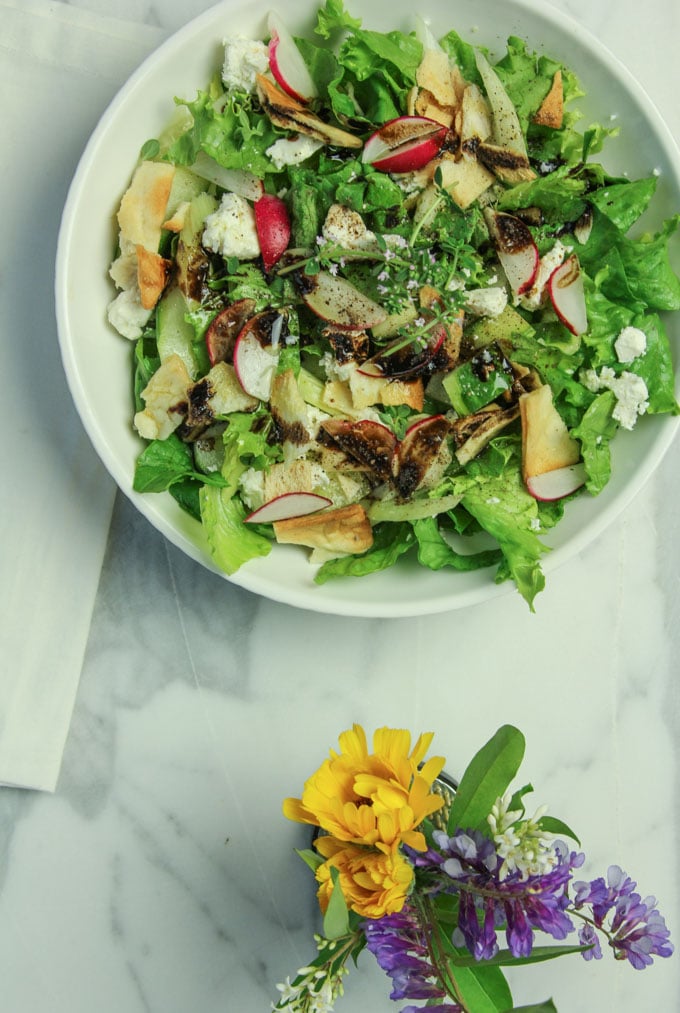
So I believe I have my mom to thank for the fact that I still enjoy my green salads with a bit of cheese.
Cheese is an important part of my formula for a balanced green salad. It starts with cheese, but there is much more in my bag of tricks if you read on.
Are you ready to learn all my secrets?
Finding balance
Whenever I make a salad, my first principle is balance. How will I create a balance of colors, textures, and flavors?
I also think about what type of food I'm having the salad with, and what type of dressing will complement the food the best.
If my food is heavy, such as beans and rice, I want a light vinaigrette dressing and lots of crunchy, bright items in the balanced green salad.
If my food is light, such as vegetables and grains, I may go for a heavier, creamy dressing. Spicy food may invite a creamy dressing for cooling.
I keep a store-bought creamy feta dressing in my fridge for these occasions, or sometimes I make a vegan caesar dressing, or there's always Ranch.
The type of dressing I choose also comes from what I am feeling that day, and what will help to create balance in the overall meal.
Vinaigrettes bring lightness to the body and cream dressings bring heaviness or grounding.
My go-to dressing
My go-to dressing is a simple vinaigrette. I am very partial to my red wine vinaigrette, because its fruity vinegary notes complement almost anything, especially my favorite salad item: feta cheese.
But even just good olive oil and lemon, lime, or balsamic vinegar can do the trick. If it’s oil and vinegar, don’t forget to add salt and pepper!
A bit of seasoning can add volumes to salads, and you may not always remember it, because store-bought salad dressings are well seasoned already, so there’s no need to add more. Use your judgement on this one.
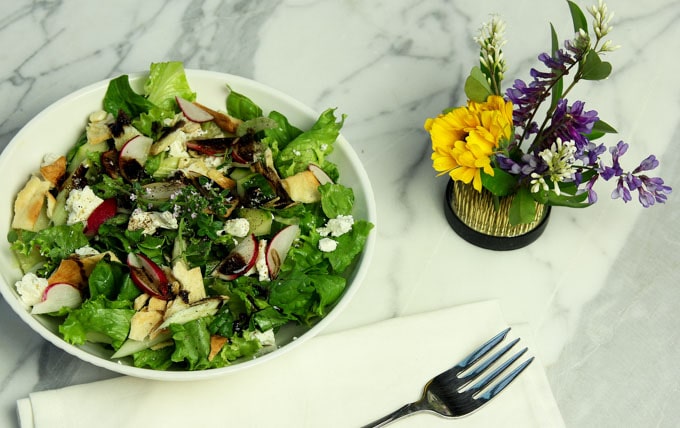
Choose your greens
The most important thing when choosing salad greens is that they be fresh and crispy, and preferably organic.
When you think about how much surface area is exposed on lettuce, I think it is worthwhile to prioritize organic lettuce.
Organic greens are also usually tastier, and they are fairly affordable, and widely available these days in the United States.
If you eat salads regularly, it doesn’t hurt to have a couple different types of greens on hand. I like to have one fresh option, and one packaged option.
You likely know that a lot of greens are sold pre-washed and packaged these days.
My opinion is that these are okay, but definitely not as good as a fresh bunch that you wash and chop yourself.
There are many reasons for this, but the most important one is vitality. Pre-washed greens are soaked in washing solution and then spun dry in commercial spinners.
Definitely some of the nutrition has leached out in this process, but then the tradeoff is that it's convenient and you get a bit more shelf life.
This is why I like to have both, and mix them together. I prioritize using the fresh greens, and stretch them with packaged greens as needed.
Any greens, weeds, and fresh shoots from the garden get picked and used up the same day. You could also add a small amount of fresh herbs, like basil, cilantro, or parsley if you have them.
Quick method to prepare fresh lettuce
To prepare fresh lettuce, I have a process that I would like to share with you, because it works really well for me and takes the pain out of the process.
Within a day or two of getting my lettuce home, while preparing dinner, I chop up the entire head, whether I need it or not.
I throw the chopped lettuce in a large bowl, fill the bowl with cold water, swish the lettuce around, and use my hands to scoop out the lettuce and transfer it to a salad spinner so the dirt stays on the bottom of the bowl. One rinse usually suffices, but you could do two if needed.
After spinning, my lettuce gets separated into two bowls.
The first bowl is the salad I am preparing for dinner, and the second is my next-day salad prep that will go into the fridge.
I then turn around and rinse out my salad spinner and washing bowl right away, and leave it to dry so the dishes don’t pile up.
Try to use a plastic bowl to store the lettuce, since plastic doesn’t conduct cold, and your lettuce will keep longer.
Before you put this bowl into the fridge, dampen a clean tea towel and cover the lettuce. Then toss any leftover salad ingredients (half a pepper, or a length of cucumber) on top of your tea towel, so when you pull out the bowl the next day, everything is right there, and ready to use.
The laborious-sounding process takes all of 4 minutes, and you’ll have greens for 2–3 salads ready to go.
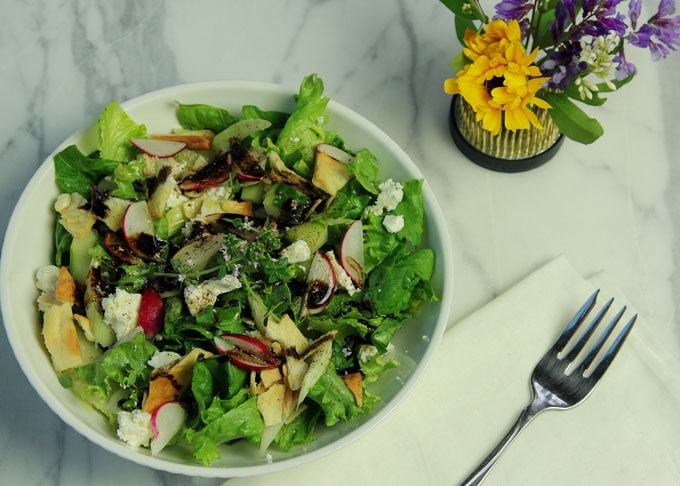
Crunchy bits
Crunch is crucial to a yummy, balanced green salad, and I am going to share my favorites with you.
CELERY: My first favorite is celery. It is an underrated vegetable, but it shouldn’t be. Some say that it requires more calories to chew celery than the vegetable provides, so we could call it pure roughage.
But it is so much more than that! Celery tastes great, and diagonally sliced chunks of celery always go into my salads.
CUCUMBER: My next go-to is cucumber. I always remove part of the peel, because the peel is hard to digest.
I learned this trick from my mom, too. I don’t take it all off though, because I believe that eating the whole vegetable is more important. So half-half is my compromise.
In general, I like to cut salad add-ins a little larger, and portion them generously. After all, who likes to eat just leaves anyway?
This way, you also get more variety when you eat your salad, and you don’t have to fiddle with getting tiny pieces on your fork. Tiny pieces are just not as satisfying to chew either.
BELL PEPPER: The next item is red bell pepper, or any other color of pepper. The red adds sweet bits, but sometimes it can be too sweet. It depends how I am feeling. I can take, or leave, peppers.
Instead of peppers, some other options that I use are radishes, kohlrabi, a few olives, sliced pickles, or jarred pepperoncini peppers.
TOMATOES: Tomatoes are almost always added to salads, but I am not a big fan unless they come fresh from the garden. These days, store-bought tomatoes are mostly unappealing. Some cherry tomatoes can be okay though. This one is up to you.
So if you don’t count the tomatoes, we have lettuce and three generous crunchy portions, plus the dressing, and the cheese.
Read the next section for the final tricks, and more particulars about the true inspiration for this balanced green salad ... the cheese of course!
The final tricks
I have one final trick to making a balanced green salad, and this is really my secret weapon.
It is pita chips. I really enjoy something dry in my salad to give an element of grounding to the dish, and to balance out all the raw food.
Crushed up pita is my favorite, but sometimes I use small cubes of sourdough bread. Sometimes it's mixed nuts or almonds.
About the cheese, I almost always choose feta. Trader Joe’s has a light feta with a dry texture that I enjoy a lot. Seriously, wasn’t feta invented for salad? It is so good.
Sometimes Parmigiano Reggiano is also great, particularly with the creamy dressings.
To me, these two cheeses are the ultimate cheeses for salad, but I don’t have a very refined cheese palate. So go for your favorites.
You don’t need to add much cheese to get a powerful, yet subtle underlying flavor punch in your salad.
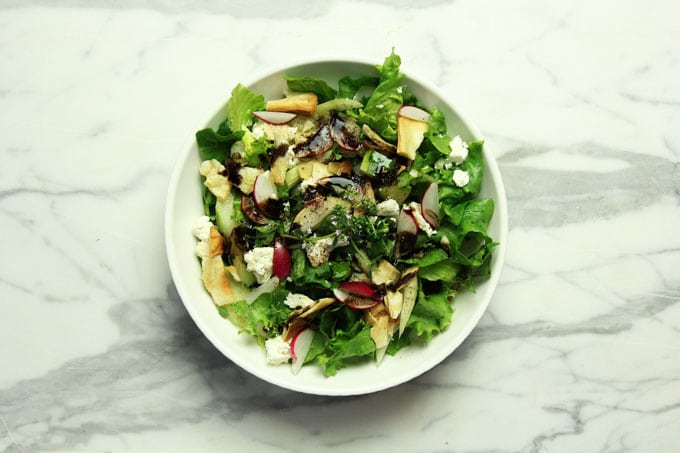
The winning combination
To recap, here is my basic salad formula:
- A mix of organic green lettuces
- Homemade vinaigrette or creamy dressing
- Celery
- Cucumber
- Bell pepper OR radishes, kohlrabi, a few olives, sliced pickles, or jarred pepperoncini peppers
- Tomatoes if you like
- Cheese: feta or Parmigiano Reggiano
- Pita chips, or sourdough cubes, or mixed nuts
This sounds crazy, but it is true that almost every time I make this kind of salad my husband comments on how much he likes it.
Sometimes it’s the cheese he comments on.
Sometimes it's the dressing he says he enjoys.
But I think it’s the crunch that does it for him every time. He is the first to admit that he enjoys crunchy foods.
So that pretty much wraps up the formula for the perfect salad.
It offers a good balance of flavors, textures, and colors, that even my husband loves.
Does your family love salad? If not, try my recipe below, and maybe you can change their minds. Or maybe you can just enjoy a wonderful salad all to yourself.

Recipe for Andrea’s Balanced Green Salad
Ingredients
- 6 cups green lettuce, washed and chopped
- 2 stalks celery, sliced on a diagonal
- ⅓ cup cucumber, sliced into chunks
- ¼ bell pepper, for other options, see notes
- ¼ cup feta, crumbled
- ⅓ cup pita chips or small sourdough bread cubes
- 2 tablespoons salad dressing, or to taste (see notes)
Instructions
- Place all prepared ingredients in a mixing bowl. Pour 2 tablespoons of dressing evenly over the top and use two forks to mix it gently.
- Transfer to a serving bowl, or individual salad bowls. If you like, garnish with salt and freshly ground pepper. Enjoy!
Notes
Nutrition
If you liked this post, please share it with your friends, or leave a comment below.
For more Buttered Veg lifestyle content, follow me on Pinterest, Facebook, Instagram, and YouTube.
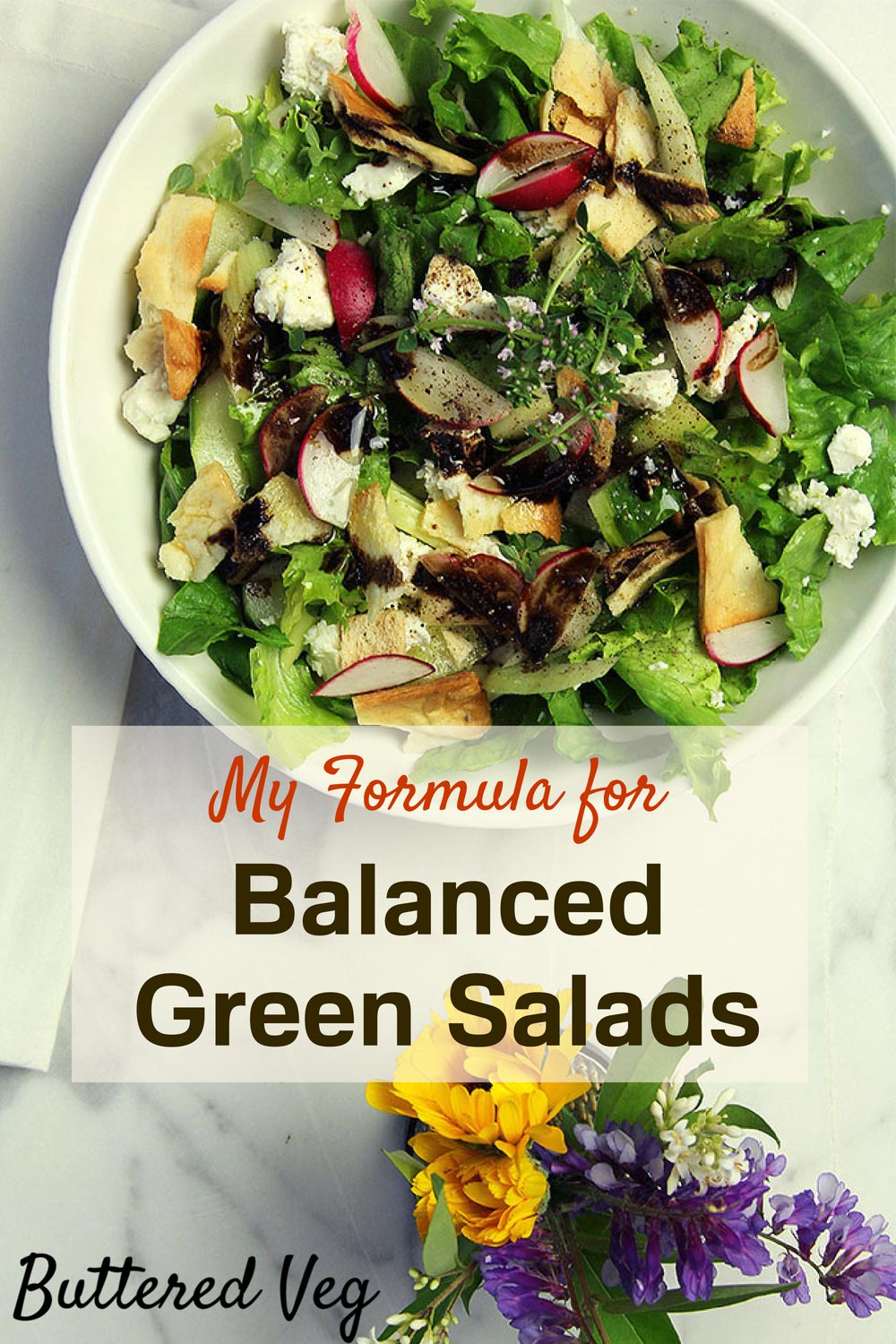



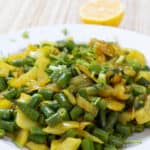




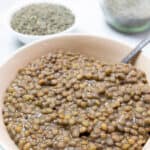
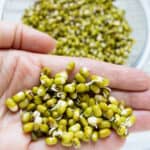
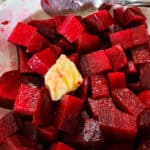


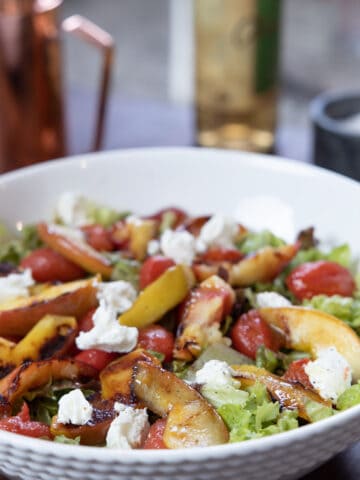
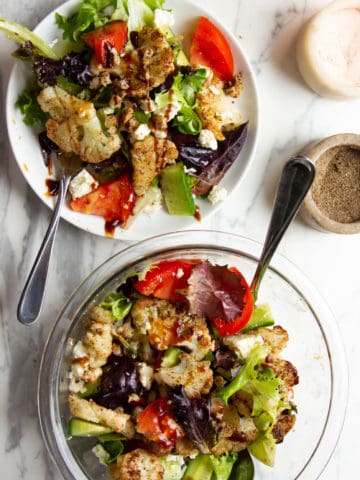
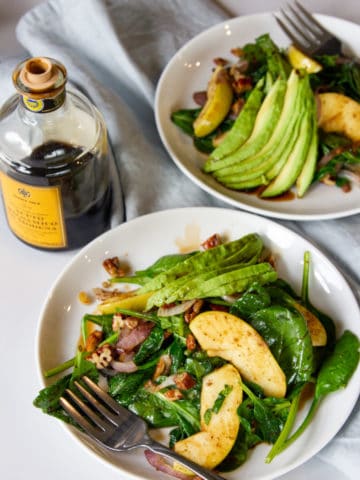
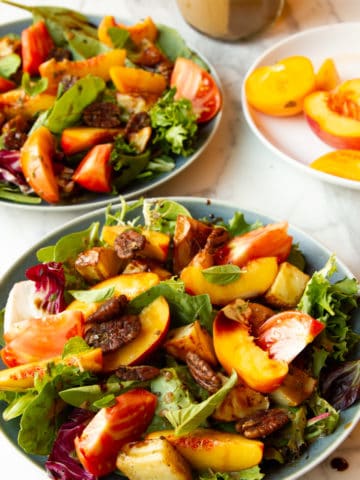
Leave a Reply